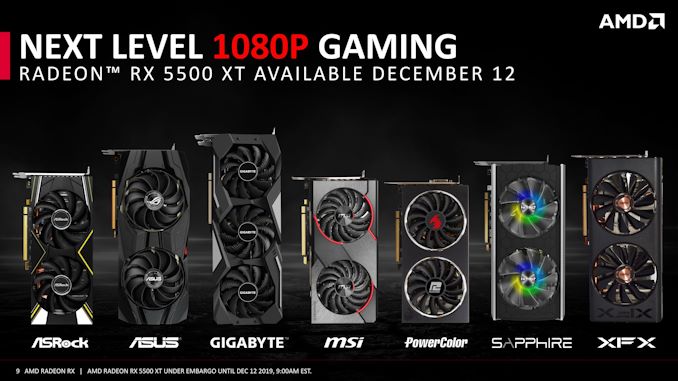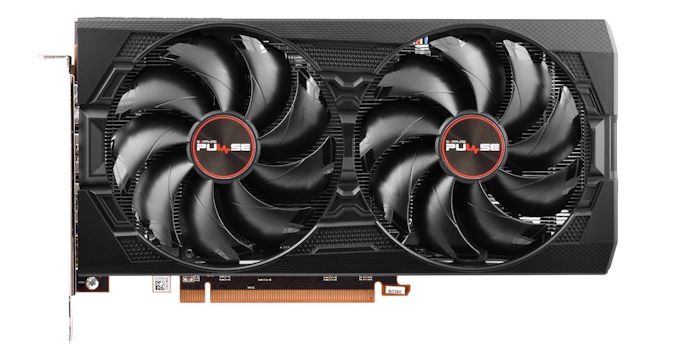The AMD Radeon RX 5500 XT Review, Feat. Sapphire Pulse: Navi For 1080p
by Ryan Smith on December 12, 2019 9:00 AM ESTClosing Thoughts
While the launch of the Radeon RX 5700 series and the underlying Navi 10 GPU was not a slam dunk for AMD’s GPU division, it was none the less an important achievement. The combination of the new RDNA core architecture as well as TSMC’s 7nm process gave AMD a significant kick in both performance efficiency and power efficiency. And in the process, it set a template for all the Radeon RX 5000 series cards to follow.
So it shouldn’t be too surprising then that the new Radeon RX 5500 XT gets to enjoy much the same situation. Compared to AMD’s previous generation Polaris-based RX 500 series cards, the 1080p-focused RX 5500 XT delivers better performance, and it does so while drawing noticeably less power. Even compared to their NVIDIA rivals, AMD is generally competitive on power efficiency in a class of cards where they were well behind in the previous generation.
Competitive performance, meanwhile, is a bit of a trickier subject. As the replacements to the RX 570/580/590 within AMD’s stack, the RX 5500 XT almost always beats AMD’s older cards, the one odd exception to this being Metro Exodus. As a result, AMD’s cheaper 4GB RX 5500 XT looks especially good here, reaching performance parity with NVIDIA’s recently launched and similarly priced GeForce GTX 1650 Super. As is usually the case, the cards are anything but equal on a game-by-game basis, constantly trading wins and losses, but at the end of the day they’re fighting over the same market with the same performance.
The 8GB RX 5500 XT, on the other hand, faces tougher competition. The extra VRAM helps to boost its performance and its price, putting it in competition with NVIDIA’s somewhat awkwardly placed GTX 1660. The GTX 1660 is an odd man out as the only current-generation GDDR5 card among the contenders, and yet it’s still fast enough to remain several percent ahead of the 8GB RX 5500 XT. To be sure, AMD’s new card puts up a great fight, coming closer to meeting NVIDIA in both performance and power efficiency than any previous AMD card; but at the end of the day it’s not enough to completely close the gap with NVIDIA’s closest competitor. Which is not to say that the RX 5500 XT is entirely outclassed here, but the GTX 1660 leads by just enough that it can’t be entirely ignored.
| Performance Summary (1080p) | ||||
| Relative Performance | Relative Price |
|||
| RX 5500 XT 4GB vs GTX 1650S | 0% | +6% | ||
| RX 5500 XT 8GB vs GTX 1660 | -8% | -5% | ||
| RX 5500 XT 8GB vs RX 580 8GB | +8% | +11% | ||
| RX 5700 vs. RX 5500 XT 8GB | +60% | +60% | ||
Throwing a wrench into all of this however – for both AMD and NVIDIA – is VRAM capacity. VRAM isn’t cheap, and GDDR6 even less so, so both vendors are using VRAM capacity as product differentiators and to upsell their better cards. But as VRAM capacity in the $150-$200 price range has been pretty stagnant for the last couple of years now, I do have some concerns about the long-term implications for the 4GB RX 5500 XT, especially with the next-generation consoles set to launch in a year’s time. With the consoles setting the baseline for most multiplatform games, it’s a reasonable bet that VRAM requirements aren’t going to stay put at 4GB much longer. So while the 4GB RX 5500 XT is a great value now, I suspect it’s going to run out of VRAM well before its compute performance gets to be a bottleneck. And while NVIDIA’s GTX 1660 fares better here with its 6GB of VRAM, 6GB is still not 8GB.
Overall then, the VRAM situation adds an extra wrinkle to any kind of product recommendations, as it’s one more variable that deserves consideration.
At the end of the day, I don’t think any 4GB cards are a great choice right now. For buyers who absolutely cannot afford to spend more than $169, then the 4GB RX 5500 XT or NVIDIA’s GeForce GTX 1650 Super counterpart are both going to be the best choices you can make right now, at least among the current-generation cards. However, spending another $30 to get a better card is going to get you a card with at least 6GB of VRAM and 6% more perforamnce, and that’s going to remain relevant for a lot longer than a 4GB card will in 2020.
Choosing between the 8GB RX 5500 XT and GTX 1660, on the other hand, is a bit harder. AMD has a 2GB VRAM advantage, which is likely to be helpful in the future; but right now they can’t match NVIDIA’s performance or feature advantage. Ultimately I’m not sure there’s a clearly correct answer here – at least, not one that can be backed entirely with hard data. In the meantime however, as the second to market it's up to AMD to make a convincing showing if they want to dislodge NVIDIA's existing GTX 1660.
As for Sapphire’s Pulse RX 5500 XT in particular, it’s hard to envision a better card to show off the Radeon RX 5500 XT. If you can look past the card’s somewhat ridiculous size for its class, the product as a whole is just about everything you could want out of a reference clocked card. The build quality is solid, the included TriXX software is handy, and the acoustics are incredible. It may not be a silent card, but with two giant fans to push plenty of air with ease, it may just as well be.
And with that, AMD is set to wrap up their GPU lineup for 2019. At only 3 Navi cards in, AMD is far from done in fleshing out a complete, top-to-bottom family of video cards. But for now, AMD is able to hit the mainstream and performance segments, which is a good place to stop for a bit and reflect as we go into the holidays.












97 Comments
View All Comments
eva02langley - Thursday, December 12, 2019 - link
Also, more wattage for a system that use less than 50% of the load will results in poor efficiency which you don't want to do.silverblue - Friday, December 13, 2019 - link
As it is, the 590 is slightly more efficient than the 580 per clock, but a minor undervolt will yield further savings. I have a TX650M which is severe overkill for a Ryzen 5 1600, 16GB DDR4 3000 and Sapphire Nitro+ RX590, which is undervolted by 8% and doesn't go above 1.1V.PeachNCream - Friday, December 13, 2019 - link
For a single CPU socket and single GPU, buying a 500W PSU is more than reasonable. You are falling into the more is better trap by probably spending more money an losing efficiency by getting something in the +750W range. That sounds like something a person that has not done any research would suggest.29a - Friday, December 13, 2019 - link
I wish they would start testing the codec ASIC on GPUs.SethNW - Thursday, December 12, 2019 - link
RX5500XT has one issue, it is the ok card. Like it is not terrible, but older RX580/590 are just too close to irlt and with prices dropping, they make more sense. And 8GB end, add a little and you get better performing 1660 or what is in a lot of cases tiny bit more and you got 1660 Super. I don't think extra 2GB of VRAM will make that huge difference at 1080p, 4GB definitely is budget category, but 6GB is doable for next 3 years. But only time will tell whether bandwidth or size will matter more.Ravynmagi_ - Thursday, December 12, 2019 - link
I was very torn up about what to buy. I wanted to stay in the $160-$180 range. I just play a couple games that are not too demanding (Civ 6 and Albion Online).I tried an RX 580, but mine has really bad coil noise. So I went with a GTX 1650. It's working perfectly for my games on a 1440p monitor.
I was uncertain if I should have waited for the RX 5500 XT. I see now it seems to provide equal performance more or less and I do prefer Nvidia drivers over AMD. So this seems to work out for me.
A part of my still nags that I should have tried another RX 580 or 590 with 8GB of RAM. But this is an entry level gaming card. If I get into more demanding games I would most likely replace whatever I bought in this price range eventually anyway before I need the 8GB of RAM I suspect.
Ravynmagi_ - Thursday, December 12, 2019 - link
Looks like I can't edit my comment. But meant to say GTX 1650 Super.eva02langley - Thursday, December 12, 2019 - link
Yeah, makes mroe sense since the 1650 GTX is a total disaster.Hrel - Thursday, December 12, 2019 - link
Looks like I'm stuck waiting for a significant price drop. I'd like to update my 280x, but it runs everything I play so the only real reason is power efficiency and system thermals. Things literally a space heater when gaming.I'm really just looking for 280x performance + 50% or so, which 1650 super does, 5500xt does, but to pay nearly $200 just to knock 75 watts off my system.... Does not appeal. Especially when the 4gb vram issue is real.
280x has 3GB ram, my system monitors have shown it tapping system ram. Not a lot, and the newest game I play is dark souls 3, 500MB. But I'm pretty sure DS3 is from 2013.
Assuming a new game that isn't esports like rocket league comes out that I want, I'd like this card to run it well.
Maybe that means I'm waiting another 2 to 4 years to replace my card. Maybe it just means waiting till next gen comes out and getting deals on these.
Either way, this generation isn't enough. From either camp.
cmdrmonkey - Thursday, December 12, 2019 - link
You already have so many other cards that are around this level of performance that I'm not sure why we needed another one. GTX 970, 1060, 1650 Super, RX 470, 480, 570, 580, 590 are all in the same ballpark as this thing depending on the game. Why did we need this? Seems like this performance segment is totally tapped out.